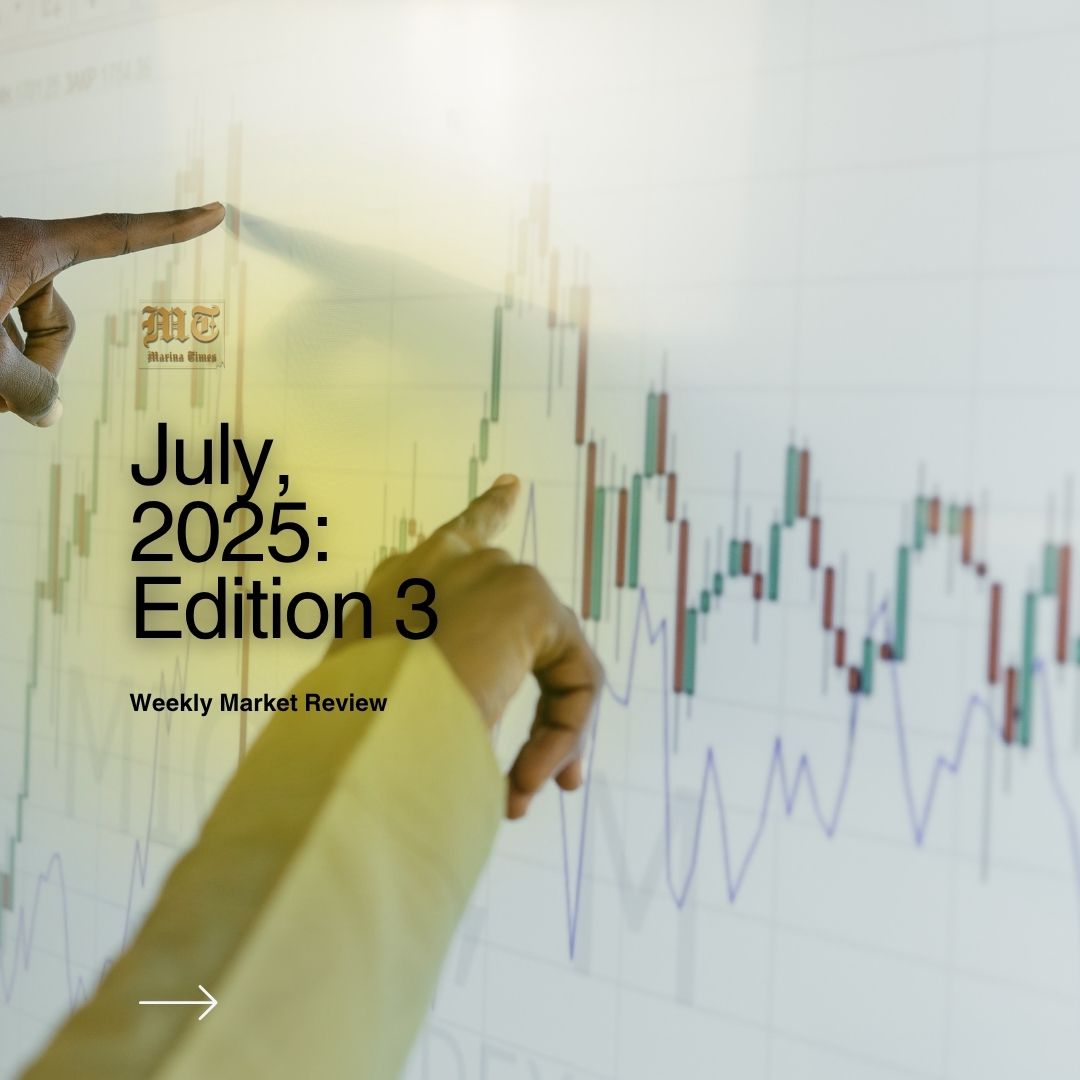

Nigeria’s economy has shown signs of cautious optimism thus far in July 2025. Headline inflation declined to 22.22% in June, marking its third consecutive monthly drop and the lowest since April. This improvement reflects both the impact of the 2024 CPI rebasing and easing inflationary pressures from the previous year. Nonetheless, food and core inflation remain elevated, with core inflation rising to 22.76%. These persistent cost pressures suggest continued monetary tightening may be necessary to sustain macroeconomic stability
Meanwhile, the Nigerian foreign exchange market offered a rare dose of optimism. The Naira appreciated to a four-month low of $/₦1,518 at the official window, buoyed by the Central Bank of Nigeria’s strategic FX interventions, tighter liquidity mop-ups, and renewed foreign portfolio flows into high-yield sovereign instruments. This momentum, coupled with rising oil production and the resumption of international Naira card transactions, reflects a gradual restoration of market confidence.
The Nigerian financial system experienced sustained liquidity deficits throughout the week, culminating in a steep shortfall of over ₦670 billion on Thursday, highlighting mounting pressure on system liquidity. The money market opened on Friday with a deficit of over ₦650 billion and consequently, interbank rates remained elevated throughout the week, with the Overnight (O/N) rate peaking at 32.75% and Open Repo Rate (OPR) at 32.42%, up from 26.00% and 30.08% levels they featured in the previous week. The Naira traded between a high of $/₦1,532.00 and a low of $/₦1,515.00 on Monday and closed at $/₦1,532.00 on Friday.
Activities in the fixed income market have become modest with rates hovering around the 16% threshold largely due to uncertainties surrounding the Monetary Policy Meeting (MPC) decision scheduled to hold this week Monday 21st July and Tuesday 22nd July 2025. It is believed that decision made at this MPC meeting will to a great extent affect investors next line of action and the overall direction of the market.
According to the National Bureau of Statistics, Nigeria’s headline inflation eased to 22.22% in June 2025, a decline of 75 basis points from 22.97% in May. This marks the third consecutive monthly decline and the lowest level since April 2025. The moderation partly reflects both the statistical impact of the 2024 Consumer Price Index (CPI) rebasing and waning pressures from last year’s inflationary spike, which peaked at 34.19% in June 2024. Despite the improved headline figure, upward pressure in food and core components underlines the uneven nature of the disinflation trend.
The gradual deceleration supports the narrative that President Tinubu’s reform agenda, including fuel subsidy removal and Naira devaluation, is beginning to cool inflation. Yet, these policy-induced shocks, while effective in resetting market dynamics, have also introduced new cost layers that continue to filter through key consumer categories.
June’s data further reveals persistent structural inflationary pressures, particularly sectors such as housing, healthcare, and transport. The rise in core inflation to 22.76%, now higher than the headline rate, suggests that underlying price momentum remains strong, indicating limited scope for monetary easing by the Central Bank of Nigeria in the near term.
For Nigeria’s capital market and broader macroeconomic outlook, the data reinforces the importance of tight monetary conditions to preserve real interest rates, anchor investor confidence, and maintain naira stability. Long-term disinflation will ultimately hinge on boosting domestic food productivity and supply chains, enhancing currency stability, and curbing imported cost pressures. Sustained inflation control remains critical to ensuring price predictability and attracting long-term capital flows.
INFLATION CATEGORY | JUNE | MAY |
HEADLINE | 22.22% | 22.97% |
FOOD | 21.97% | 21.14% |
CORE | 22.76% | 22.28% |
In mid-July 2025, the Nigerian Naira appreciated to a four-month high of ₦1,518/$ on the official market, gaining approximately 0.74% in a single session and marking its strongest level since mid-March. The parallel market followed suit, with the naira strengthening to around ₦1,550/$ from ₦1,660 at the start of the year, representing a notable 1.4% year-to-date gain as of July 16th. Analysts attribute this rebound to proactive Central Bank of Nigeria (CBN) measures, including a $50 million FX sale last week, tighter open market operations, and increased foreign portfolio inflows into Nigeria’s high-yield sovereign debt instruments.
The Naira revaluation, followed by enhanced FX liquidity and disciplined policy execution, offers significant macroeconomic benefits. It helps anchor inflation expectations, sustain real interest rates, and boost confidence in Nigeria’s capital markets. As the CBN continues to defend the currency within a relatively stable band, this signals a window of FX stability, offering clarity for investors and policymakers alike. The sustained flow of foreign capital and steady CBN support are proving instrumental in maintaining economic balance.
Further reflecting this recovery, major lenders have resumed international transactions on Naira-denominated debit cards, lifting a three-year restriction linked to past dollar shortages. This restoration of services underscores renewed confidence in Nigeria’s FX architecture, supported by robust portfolio inflows and the CBN’s active interventions. Moreover, June crude oil production climbed to 1.547 million barrels per day, the highest since January, strengthening Nigeria’s external position and reinforcing the Naira’s upward momentum, even amid volatile global monetary dynamics.
Interbank money market liquidity remained under strain throughout the past week, showing signs of a heightened squeeze. On Monday, the market opened with a deficit of over ₦280 billion, plunge further to a shortfall of over ₦672 billion on Wednesday, reflecting intensified funding pressure and closed at a deficit of ₦659.9 billion on Friday, despite inflows of over ₦65 billion, the system remained illiquid, indicating persistent cash constraints. This sustained liquidity deficit underscores the CBN’s deliberate liquidity mop-up efforts ahead of the forthcoming Monetary Policy Committee (MPC) meeting, where expectations are tilted toward a firm policy stance to anchor inflation and manage FX stability.
The Nigerian All-Share Index (ASI) marked a sustained upward trend in the third trading week of July. It gained 4,897.00 points during the week, rising from 126,689.00 on Monday, July 14 to 131,586.00 on Friday, July 18, reflecting a 3.87% gain over the period. This performance underscores strong bullish momentum and renewed investor confidence in the equities market.
Crude oil markets ended the second week of July on a cautious note, with prices swinging on the back of heightened geopolitical risks and renewed trade tensions. Brent crude hovered just under $70 per barrel, while WTI settled around $68, recouping some midweek losses. Early gains were fuelled by a fresh round of supply-side disruptions, including U.S. sanction threats against Russia, drone attacks in Iraq’s Kurdistan region, and Israeli airstrikes in Syria, briefly reviving the geopolitical risk premium in the oil complex.
However, momentum faded as President Trump issued a 50-day ceasefire ultimatum to Moscow, tempering fears of an immediate supply shock. Further, the White House confirmed a sweeping 30% tariffs on imports from the EU and Mexico, effective August 1, rekindling concerns about a potential slowdown in global trade and demand. The trade jitters cast a long shadow over an otherwise resilient demand narrative, complicating the market’s near-term outlook.
Still, some tailwinds offered support. U.S. gasoline demand strengthened with the summer driving season, while China’s June refinery throughput rose by 8.5% year-on-year, signalling stable Asian demand. A 3.9 million-barrel draw in U.S. crude inventories, reported by the EIA, also helped balance market sentiment, although surprise builds in gasoline and diesel stocks raised questions. Despite these positives, both Brent and WTI were on track for a weekly loss of over 1%; their first in three weeks, as investor sentiment wavers amid mounting policy risks. The road ahead will likely be shaped by how markets digest the unfolding trade policy, OPEC+ signals, and Russia’s response to Western pressure.
As Nigeria’s macroeconomic landscape begins to show early signs of stabilization evidenced by the Naira’s appreciation, easing headline inflation, and improving oil production, investors are sharply focused on the forthcoming Monetary Policy Committee (MPC) meeting. The CBN is widely expected to maintain its tightening stance or possibly introduce calibrated adjustments to sustain a disinflation momentum and reinforce exchange rate stability.
This week, inflows of over ₦542 billion from coupon payments and maturities are expected to provide a liquidity boost to the financial system. Should the CBN hold off on liquidity sterilisation via auctions, this could offer a short-term relief to funding conditions and support market stability.
Market participants remain watchful for signals on policy direction, especially as the CBN balances the need to anchor inflation expectations with the imperative to sustain real returns on naira assets. A sustained hold in the benchmark rate could help consolidate recent currency gains and maintain investor interest in local debt markets. With FX liquidity improving and confidence slowly returning to the financial system, the decisions at the MPC meeting slated for July 20th – 21st, may prove pivotal in shaping Nigeria’s short-term macroeconomic trajectory, particularly in capital markets and with cross-border investor sentiments. There are also growing inflationary pressures attributable to monthly statutory credits to states and local governments through the banking system. This concern will likely further reinforce the need to hold parameters in the interim.
The execution of the Genius Act by President Donald Trump is expected to propel cryptocurrencies to test new highs this week, however the sustainability of highs will remain tested by profit taking as we have witnessed at every new high in the recent sequence.
Mid-July saw the oil market hold its breath. The second week was caught in a storm of volatility, like strong winds over still waters. Triggering a chaotic dance of the barrels that left traders uncertain and markets adrift.
Prices swayed like the waves… Brent hovered near the $70 mark while WTI neared $68… both suspended in uneasy anticipation.
But in the Oil games, it’s not all about supply and demand; uncertainty is also a key.
From geopolitical clouds, the spark came: Kurdistan unleashed strikes, Syria lit up under Israeli bombardments, and Trump threatens Moscow with a 50-day ceasefire!! Meanwhile, a looming tariff war brews with 30% duties on EU and Mexican goods slated for August 1st…
In this climate, conflict tightens supply. Every barrel becomes a bargaining chip.
While demand remains resilient, hope and anxiety now move in tandem. And so, oil traders keep watching cautiously and restlessly as the dance of the barrels continues across a trembling global stage.
By: Sandra A. Aghaizu